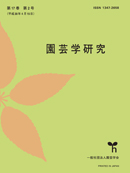Volume 18, Issue 3
Displaying 1-13 of 13 articles from this issue
- |<
- <
- 1
- >
- >|
REPORTS
Breeding & Germplasm Resources
-
2019Volume 18Issue 3 Pages 207-213
Published: 2019
Released on J-STAGE: September 30, 2019
Download PDF (1018K) -
2019Volume 18Issue 3 Pages 215-226
Published: 2019
Released on J-STAGE: September 30, 2019
Download PDF (1683K)
Propagation & Transplant Production
-
2019Volume 18Issue 3 Pages 227-233
Published: 2019
Released on J-STAGE: September 30, 2019
Download PDF (2445K) -
2019Volume 18Issue 3 Pages 235-241
Published: 2019
Released on J-STAGE: September 30, 2019
Download PDF (1064K)
Crop Production & Cropping Type
-
2019Volume 18Issue 3 Pages 243-251
Published: 2019
Released on J-STAGE: September 30, 2019
Download PDF (1792K) -
2019Volume 18Issue 3 Pages 253-258
Published: 2019
Released on J-STAGE: September 30, 2019
Download PDF (4777K) -
2019Volume 18Issue 3 Pages 259-267
Published: 2019
Released on J-STAGE: September 30, 2019
Download PDF (3032K) -
2019Volume 18Issue 3 Pages 269-279
Published: 2019
Released on J-STAGE: September 30, 2019
Download PDF (1447K)
Growth Regulation
-
2019Volume 18Issue 3 Pages 281-288
Published: 2019
Released on J-STAGE: September 30, 2019
Download PDF (2939K)
Postharvest Physiology & Technology
-
2019Volume 18Issue 3 Pages 289-294
Published: 2019
Released on J-STAGE: September 30, 2019
Download PDF (6874K) -
2019Volume 18Issue 3 Pages 295-303
Published: 2019
Released on J-STAGE: September 30, 2019
Download PDF (3572K)
NEW TECHNOLOGY
-
2019Volume 18Issue 3 Pages 305-312
Published: 2019
Released on J-STAGE: September 30, 2019
Download PDF (3157K)
NEW CULTIVAR
-
2019Volume 18Issue 3 Pages 313-315
Published: 2019
Released on J-STAGE: September 30, 2019
Download PDF (2059K)
- |<
- <
- 1
- >
- >|
